Stable and Metastable Patterns in Chromonic Nematic Liquid Crystal Droplets Forced with Static and Dynamic Magnetic Fields
Abstract
:1. Introduction
2. Experimental Methods
2.1. Sample Preparation
2.2. Observation and Control
2.3. Image Analysis and Simulated Textures
3. Results and Discussion
3.1. Structure of the Nematic Gems
3.2. Nematic Gems in a Static Magnetic Field
3.3. Transition to Bipolar Nematic Gems Under a Rotating Magnetic Field
3.4. SSY Nematic Emulsions Under a Magnetic Field
4. Conclusions
Supplementary Materials
Author Contributions
Funding
Conflicts of Interest
References
- Oswald, P.; Pieranski, P. Nematic and Cholesteric Liquid Crystals: Concepts and Physical Properties Illustrated by Experiments; The Liquid Crystals Book Series; Taylor & Francis: Boca Raton, FL, USA, 2005. [Google Scholar]
- Kléman, M.; Lavrentovich, O.D. Soft Matter Physics: An Introduction; Partially Ordered Systems; Springer: New York, NY, USA, 2003. [Google Scholar]
- Kleman, M. Defects in liquid crystals. Rep. Prog. Phys. 1989, 52, 555–654. [Google Scholar] [CrossRef]
- Smalyukh, I.I. Liquid Crystal Colloids. Annu. Rev. Condens. Matter Phys. 2017, 9, 207–226. [Google Scholar] [CrossRef]
- Tai, J.S.B.; Smalyukh, I.I. Three-dimensional crystals of adaptive knots. Science 2019, 365, 1449–1453. [Google Scholar] [CrossRef] [PubMed] [Green Version]
- Senyuk, B.; Liu, Q.; He, S.; Kamien, R.D.; Kusner, R.B.; Lubensky, T.C.; Smalyukh, I. Topological colloids. Nature 2013, 493, 200–205. [Google Scholar] [CrossRef] [PubMed] [Green Version]
- Lopez-Leon, T.; Fernandez-Nieves, A. Drops and shells of liquid crystal. Colloid Polym. Sci. 2011, 289, 345–359. [Google Scholar] [CrossRef]
- Mondiot, F.; Wang, X.; de Pablo, J.J.; Abbott, N.L. Liquid crystal-based emulsions for synthesis of spherical and non-spherical particles with chemical patches. J. Am. Chem. Soc. 2013, 135, 9972–9975. [Google Scholar] [CrossRef] [PubMed] [Green Version]
- Musevic, I. Liquid Crystal Colloids. In Soft and Biological Matter; Springer Nature: Cham, Switzerland, 2017. [Google Scholar]
- Ondris-Crawford, R.; Boyko, E.P.; Wagner, B.G.; Erdmann, J.H.; Žumer, S.; Doane, J.W. Microscope textures of nematic droplets in polymer dispersed liquid crystals. J. Appl. Phys. 1991, 69, 6380–6386. [Google Scholar] [CrossRef]
- Miller, D.S.; Wang, X.; Abbott, N.L. Design of Functional Materials based on Liquid Crystalline Droplets. Chem. Mater. 2014, 26, 496–506. [Google Scholar] [CrossRef] [Green Version]
- Hakemi, H. Polymer-dispersed liquid crystal technology ‘industrial evolution and current market situation’. Liq. Cryst. Today 2017, 26, 70–73. [Google Scholar] [CrossRef]
- Sivakumar, S.; Wark, K.L.; Gupta, J.K.; Abbott, N.L.; Caruso, F. Liquid Crystal Emulsions as the Basis of Biological Sensors for the Optical Detection of Bacteria and Viruses. Adv. Funct. Mater. 2009, 19, 2260–2265. [Google Scholar] [CrossRef]
- Manna, U.; Zayas-Gonzalez, Y.M.; Carlton, R.J.; Caruso, F.; Abbott, N.L.; Lynn, D.M. Liquid crystal chemical sensors that cells can wear. Angew. Chem. Int. Ed. Engl. 2013, 52, 14011–14015. [Google Scholar] [CrossRef] [PubMed]
- Tone, C.M.; De Santo, M.P.; Buonomenna, M.G.; Golemme, G.; Ciuchi, F. Dynamical homeotropic and planar alignments of chromonic liquid crystals. Soft Matter 2012, 8, 8478. [Google Scholar] [CrossRef]
- Jeong, J.; Han, G.; Johnson, A.T.; Collings, P.J.; Lubensky, T.C.; Yodh, A.G. Homeotropic alignment of lyotropic chromonic liquid crystals using noncovalent interactions. Langmuir 2014, 30, 2914–2920. [Google Scholar] [CrossRef]
- Fernández-Nieves, A.; Link, D.; Márquez, M.; Weitz, D. Topological Changes in Bipolar Nematic Droplets under Flow. Phys. Rev. Lett. 2007, 98, 087801. [Google Scholar] [CrossRef] [PubMed] [Green Version]
- Jiang, J.; Yang, D.K. Bipolar to toroidal configuration transition in liquid crystal droplets. Liq. Cryst. 2017, 45, 102–111. [Google Scholar] [CrossRef]
- Jeong, J.; Davidson, Z.S.; Collings, P.J.; Lubensky, T.C.; Yodh, A.G. Chiral symmetry breaking and surface faceting in chromonic liquid crystal droplets with giant elastic anisotropy. Proc. Natl. Acad. Sci. USA 2014, 111, 1742–1747. [Google Scholar] [CrossRef] [Green Version]
- Tam-Chang, S.W.; Huang, L. Chromonic liquid crystals: properties and applications as functional materials. Chem. Commun. (Camb.) 2008, 1957–1967. [Google Scholar] [CrossRef]
- Park, H.S.; Lavrentovich, O. Lyotropic Chromonic Liquid Crystals:Emerging Applications. In Liquid Crystals Beyond Displays: Chemistry, Physics, and Applications; Li, Q., Ed.; John Wiley & Sons, Inc.: Hoboken, NJ, USA, 2012; Chapter 14. [Google Scholar]
- Xu, F.; Crooker, P. Chiral nematic droplets with parallel surface anchoring. Phys. Rev. E 1997, 56, 6853–6860. [Google Scholar] [CrossRef]
- Drzaic, P.S. A case of mistaken identity: spontaneous formation of twisted bipolar droplets from achiral nematic materials. Liq. Cryst. 1999, 26, 623–627. [Google Scholar] [CrossRef]
- Zhou, S.; Nastishin, Y.; Omelchenko, M.; Tortora, L.; Nazarenko, V.; Boiko, O.; Ostapenko, T.; Hu, T.; Almasan, C.; Sprunt, S.; et al. Elasticity of Lyotropic Chromonic Liquid Crystals Probed by Director Reorientation in a Magnetic Field. Phys. Rev. Lett. 2012, 109, 037801. [Google Scholar] [CrossRef] [Green Version]
- Ignes-Mullol, J.; Poy, G.; Oswald, P. Continuous Rotation of Achiral Nematic Liquid Crystal Droplets Driven by Heat Flux. Phys. Rev. Lett. 2016, 117, 057801. [Google Scholar] [CrossRef] [PubMed] [Green Version]
- Park, H.S.; Kang, S.W.; Tortora, L.; Nastishin, Y.; Finotello, D.; Kumar, S.; Lavrentovich, O.D. Self-assembly of lyotropic chromonic liquid crystal Sunset Yellow and effects of ionic additives. J. Phys. Chem. B 2008, 112, 16307–16319. [Google Scholar] [CrossRef] [PubMed]
- Abate, A.R.; Weitz, D.A. Syringe-vacuum microfluidics: A portable technique to create monodisperse emulsions. Biomicrofluidics 2011, 5, 14107. [Google Scholar] [CrossRef] [Green Version]
- Soltner, H.; Blümler, P. Dipolar Halbach magnet stacks made from identically shaped permanent magnets for magnetic resonance. Concepts Magn. Reson. Part A 2010, 36A, 211–222. [Google Scholar] [CrossRef]
- Guillamat, P.; Ignes-Mullol, J.; Sagues, F. Control of active liquid crystals with a magnetic field. Proc. Natl. Acad. Sci. USA 2016, 113, 5498–5502. [Google Scholar] [CrossRef] [Green Version]
- Yeh, P.; Gu, C. Optics of Liquid Crystal Displays; Wiley Series in Pure And Applied Optics; Wiley: New York, NY, USA, 1999. [Google Scholar]
- Ellis, P.W.; Pairam, E.; Fernández-Nieves, A. Simulating optical polarizing microscopy textures using Jones calculus: A review exemplified with nematic liquid crystal tori. J. Phys. Appl. Phys. 2019, 52, 213001. [Google Scholar] [CrossRef]
- Horowitz, V.R.; Janowitz, L.A.; Modic, A.L.; Heiney, P.A.; Collings, P.J. Aggregation behavior and chromonic liquid crystal properties of an anionic monoazo dye. Phys. Rev. E 2005, 72, 041710. [Google Scholar] [CrossRef] [Green Version]
- Giomi, L.; Kos, Z.; Ravnik, M.; Sengupta, A. Cross-talk between topological defects in different fields revealed by nematic microfluidics. Proc. Natl. Acad. Sci. USA 2017, 114, E5771–E5777. [Google Scholar] [CrossRef] [Green Version]
- Xu, F.; Kitzerow, H.; Crooker, P.P. Electric-field effects on nematic droplets with negative dielectric anisotropy. Phys. Rev. A 1992, 46, 6535–6540. [Google Scholar] [CrossRef]
- Oswald, P. Easy axis memorization with active control of the azimuthal anchoring energy in nematic liquid crystals. EPL (Europhys. Lett.) 2014, 107, 26003. [Google Scholar] [CrossRef]
- Burriel, P.; Ignes-Mullol, J.; Reigada, R.; Sagues, F. Collective molecular precession induced by rotating illumination in photosensitive Langmuir monolayers. Langmuir 2006, 22, 187–193. [Google Scholar] [CrossRef] [PubMed]
- Yoshioka, J.; Ito, F.; Suzuki, Y.; Takahashi, H.; Takizawa, H.; Tabe, Y. Director/barycentric rotation in cholesteric droplets under temperature gradient. Soft Matter 2014, 10, 5869–5877. [Google Scholar] [CrossRef] [PubMed]
- Poy, G.; Oswald, P. Do Lehmann cholesteric droplets subjected to a temperature gradient rotate as rigid bodies? Soft Matter 2016, 12, 2604–2611. [Google Scholar] [CrossRef] [PubMed]
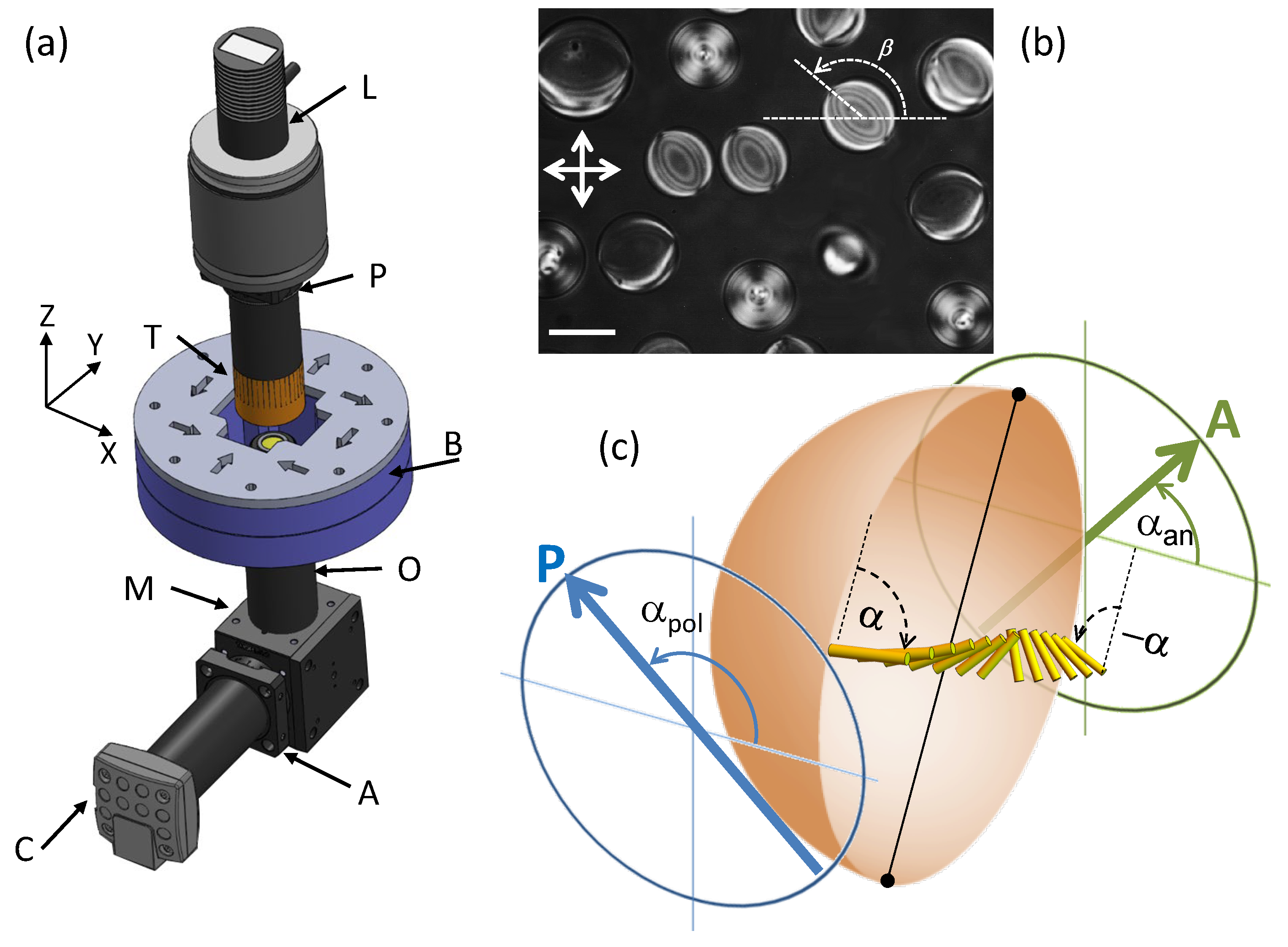
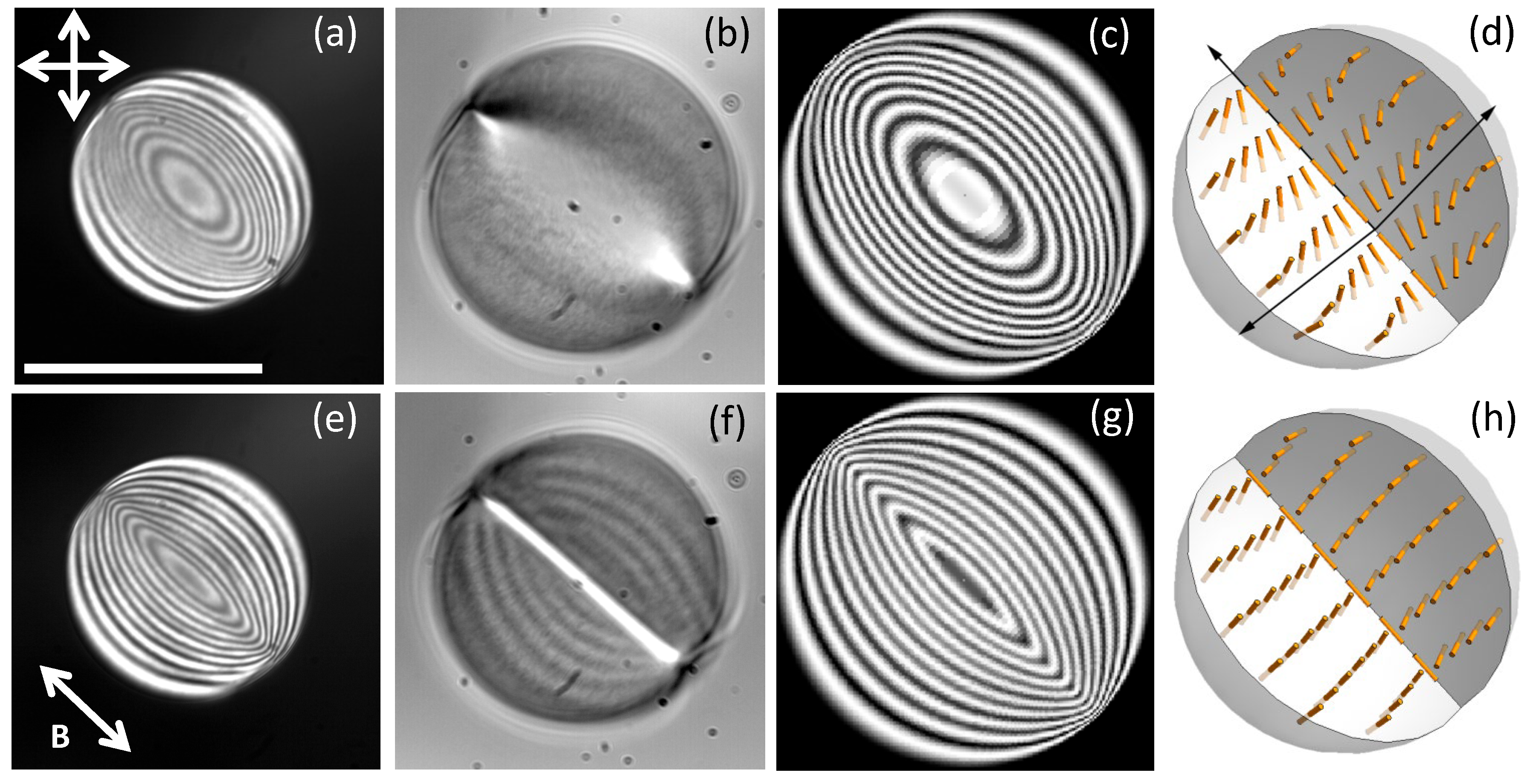

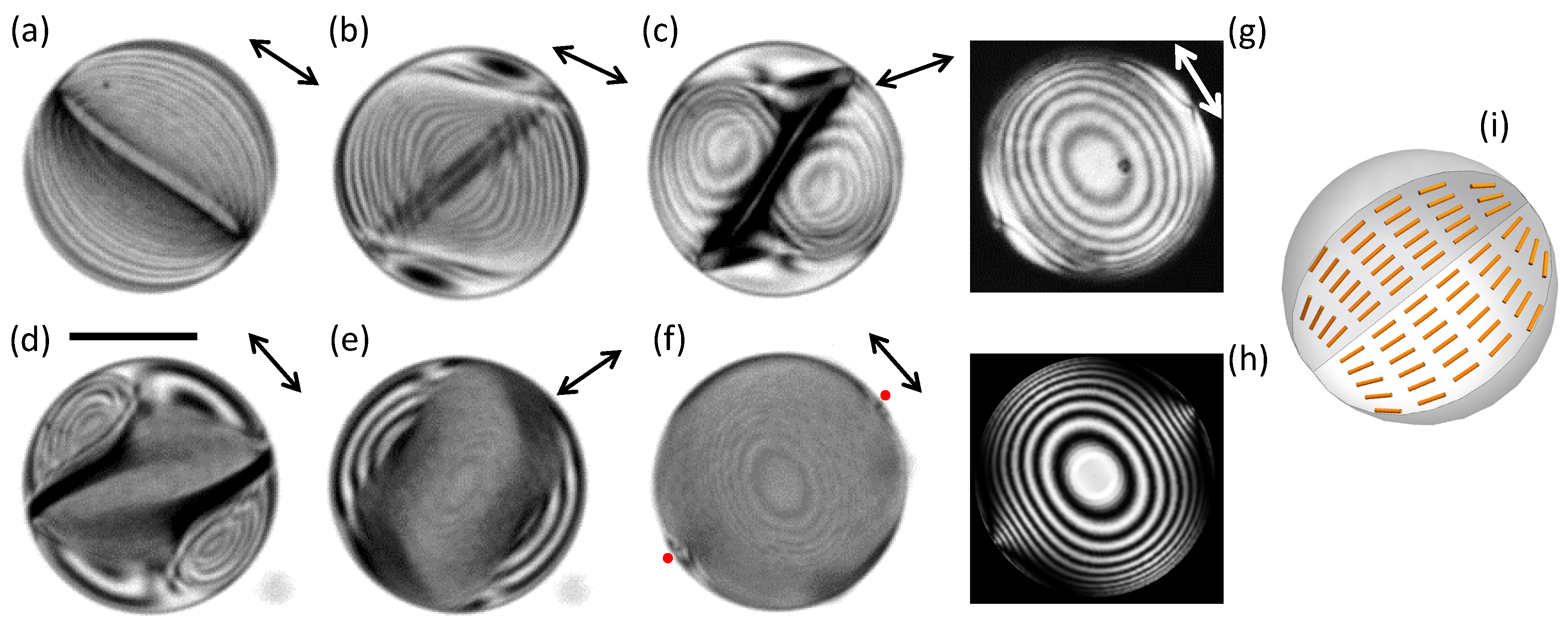

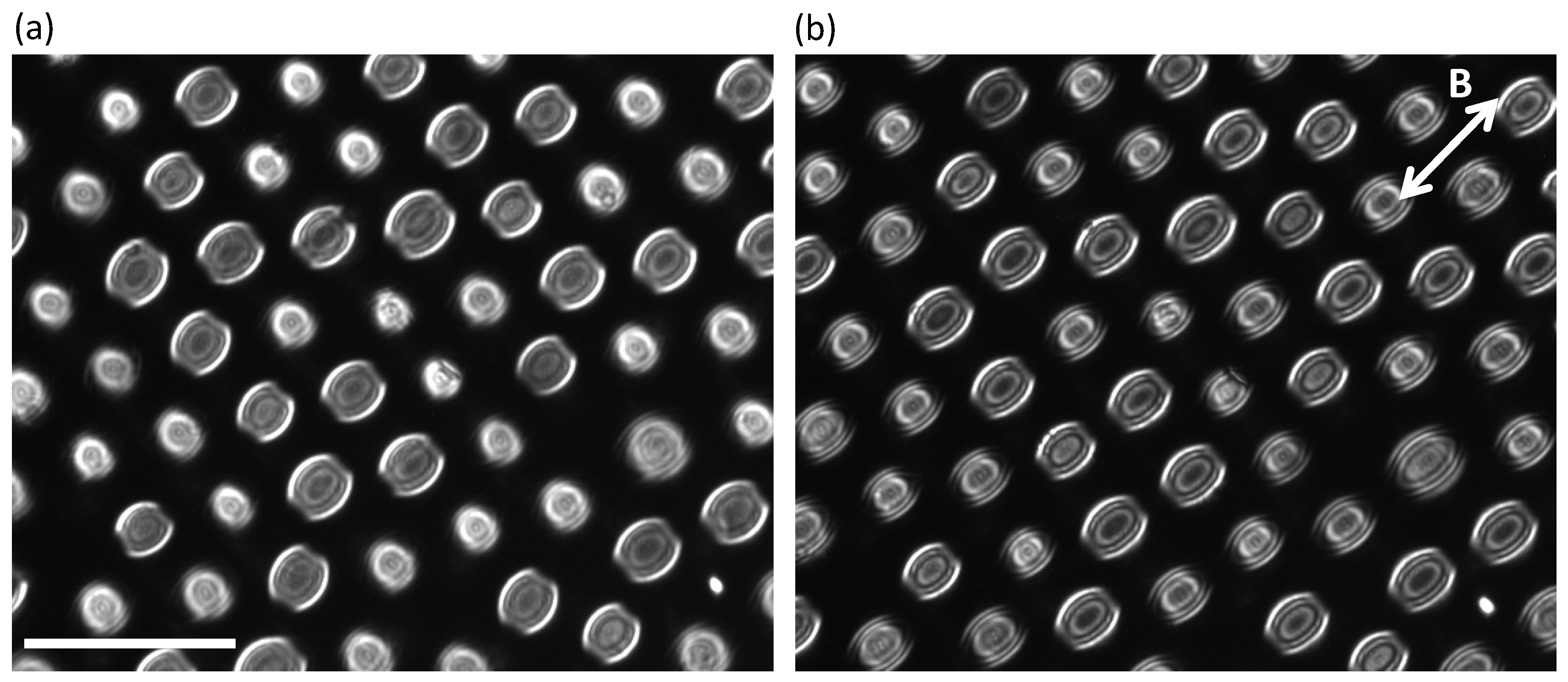
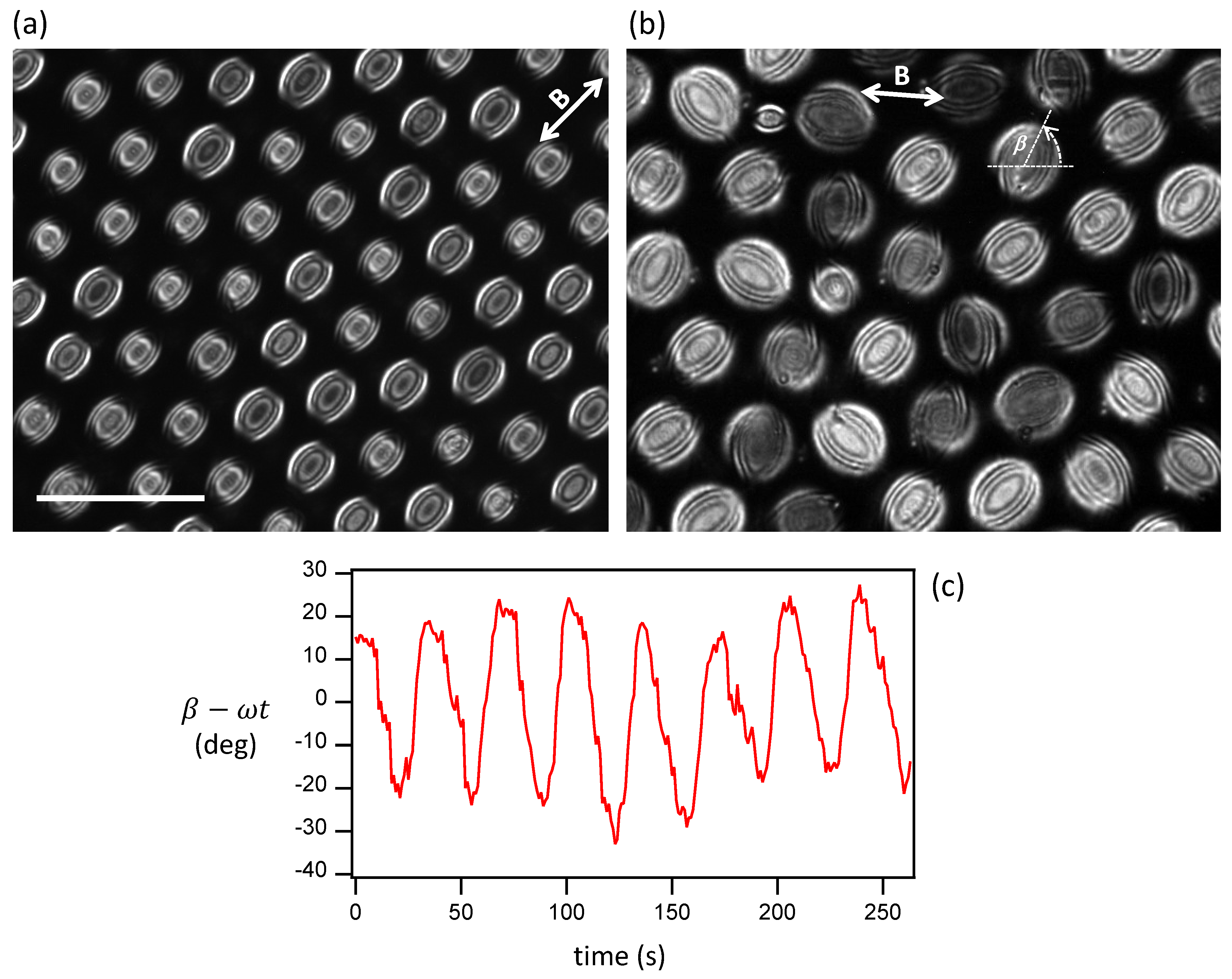
© 2020 by the authors. Licensee MDPI, Basel, Switzerland. This article is an open access article distributed under the terms and conditions of the Creative Commons Attribution (CC BY) license (http://creativecommons.org/licenses/by/4.0/).
Share and Cite
Ignés-Mullol, J.; Mora, M.; Martínez-Prat, B.; Vélez-Cerón, I.; Herrera, R.S.; Sagués, F. Stable and Metastable Patterns in Chromonic Nematic Liquid Crystal Droplets Forced with Static and Dynamic Magnetic Fields. Crystals 2020, 10, 138. https://doi.org/10.3390/cryst10020138
Ignés-Mullol J, Mora M, Martínez-Prat B, Vélez-Cerón I, Herrera RS, Sagués F. Stable and Metastable Patterns in Chromonic Nematic Liquid Crystal Droplets Forced with Static and Dynamic Magnetic Fields. Crystals. 2020; 10(2):138. https://doi.org/10.3390/cryst10020138
Chicago/Turabian StyleIgnés-Mullol, Jordi, Marc Mora, Berta Martínez-Prat, Ignasi Vélez-Cerón, R. Santiago Herrera, and Francesc Sagués. 2020. "Stable and Metastable Patterns in Chromonic Nematic Liquid Crystal Droplets Forced with Static and Dynamic Magnetic Fields" Crystals 10, no. 2: 138. https://doi.org/10.3390/cryst10020138




